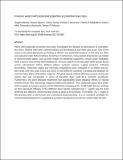| dc.description.abstract | Plants with pesticidal properties have been investigated for decades as alternatives to synthetics, but only a handful have been commercialised and developed as non-food cash crops. One of the reasons why pesticidal plants are failing to deliver new pesticidal products is that they are often not evaluated under field conditions by farmers. Furthermore, many aspects of pesticide use related to environmental safety, such as their impact on beneficial organisms, remain under-evaluated. With a view to overcoming these bottlenecks, extracts made from six abundant weed species found across sub-Saharan Africa (Bidens pilosa, Lantana camara, Lippia javanica, Tithonia diversifolia, Tephrosia vogelii and Vernonia amygdalina) were evaluated in on-station and on-farm trials over two years (2015 and 2016) in two different countries (Tanzania and Malawi) on common bean plants (Phaseolus vulgaris). All plant species offered effective control of key pest species that was comparable in terms of harvested bean yield to a synthetic pyrethroid. Furthermore, the plant pesticide treatments had significantly lower negative effects on natural enemies (hover flies, lacewings, ladybird beetles and spiders). Thus, pesticidal plants were better able to support ecosystem services whilst effectively managing pests. Small holder farmer rankings on their perceived efficacy of the different plant species indicated that T. vogelii was the most preferred and effective, achieving bean yields as good as the synthetic, if not better. As T. vogelii is fast growing with a well-known and understood phytochemistry, it is an excellent candidate for commercial development to supplement pyrethrum production by African small holder farmers. | en_US |

